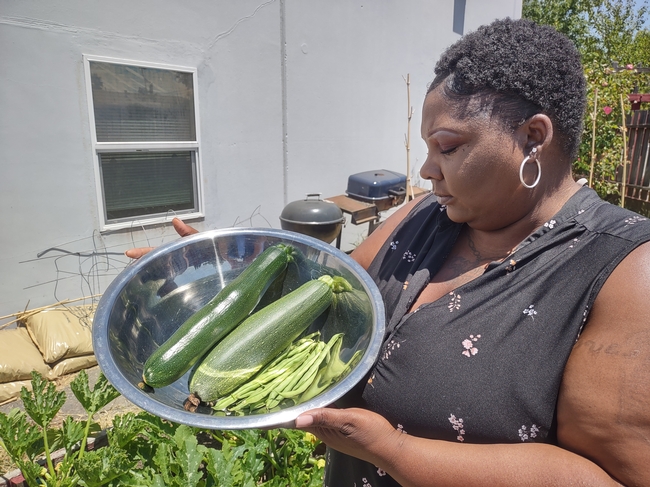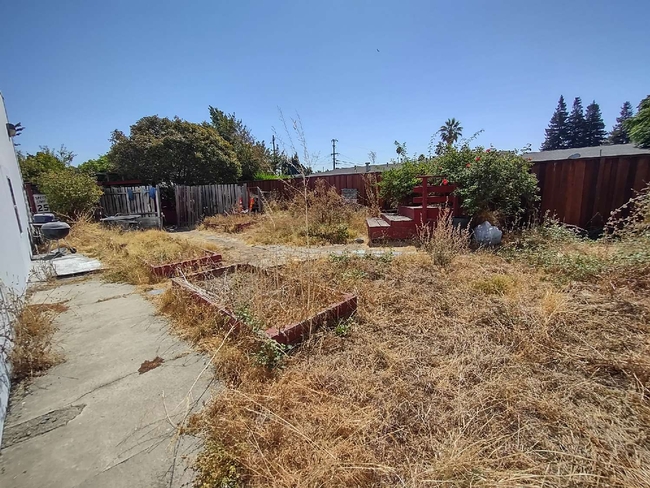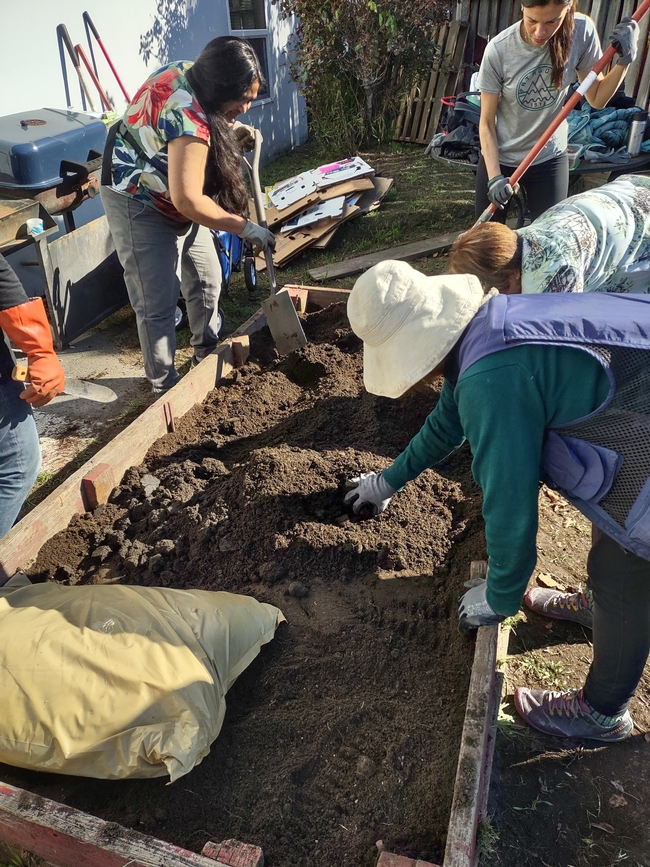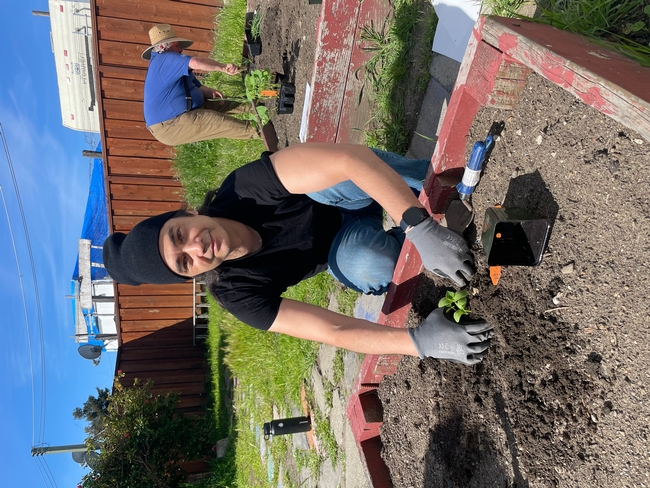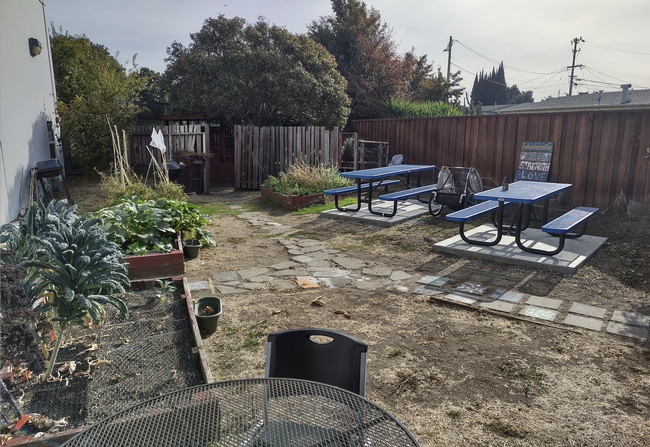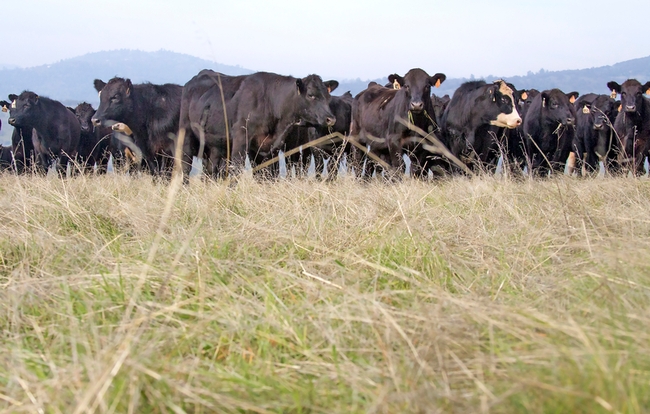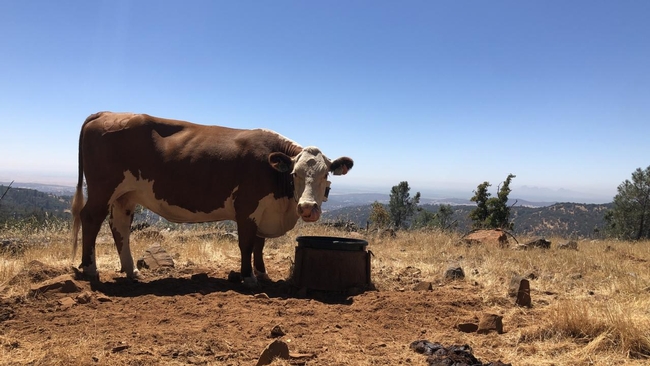UC Food and Agriculture Blogs
Homeless people cultivate food, better health while gardening in Alameda County
Fresh fruits and vegetables are essential to a healthful diet, but it's hard to keep perishable foods on hand if one doesn't have a refrigerator or a home. To enhance the health of homeless people, the CalFresh Healthy Living, UC Cooperative Extension team in Alameda County has partnered with the South County Homeless Project to grow fresh produce for people staying at the emergency housing in Hayward.
For the past seven years, CalFresh Healthy Living, UCCE Alameda has been delivering nutrition lessons to residents of the South County Homeless Project, part of Building Opportunities for Self Sufficiency. The classes include Rethink Your Drink, Food Safety, Making Every Dollar Count, Eat Healthy Be Active Community Workshops, and Fresh from the Garden.
The South County Homeless Project facility houses 24 people for up to a year. With the help of the CalFresh Healthy Living, UC Cooperative Extension team, its existing garden was refurbished and redesigned. The large outdoor garden behind the facility offers therapeutic gardening opportunities to residents and provides food for their meals.
"I love the garden and when the cook cooks the vegetables, they taste amazing,” said one resident. “I am thankful for this garden and for having the CalFresh Healthy Living team.”
At one time, South County Homeless Project's backyard featured a flower garden. After years of neglect, weeds overtook the garden.
In 2022, CalFresh Healthy Living, UCCE Alameda proposed getting residents involved in growing food by resurrecting the garden with edible plants.
“Not only could we continue to engage residents in nutrition education classes, but we could also work together to reinvigorate their neglected garden,” said MaxFairbee, nutrition educator withCalFresh Healthy Living team,UCCE Alameda.
More than 15 varieties of herbs and vegetables planted
Residents and staff set out to replace the weedy beds with a vegetable and herb garden.
“We worked with South County staff and residents on the design, clean up, planting, harvesting and ultimately incorporating food from the garden into the kitchen for residents to enjoy the fruits of their labor,” Fairbee said.
For gardening expertise and support, Fairbee enlisted the UC Master Gardeners of Alameda County's Community Garden Team to help. While the CalFresh Healthy Living, UCCE staff continued providing nutrition classes, the UC Master Gardener volunteers trained the residents on the basics of gardening.
In April, after heavy rains, the group planted 50 seedlings, half donated by the UC Master Gardeners. They planted two varieties of lettuce,arugula, four varieties of tomatoes, zucchini, kale, onions, cucumbers, green beans, Swiss chard, kale, basil, cilantro, tarragon, thyme, parsley, rosemary, oregano and mint.
From garden to table
“In May, we harvested lettuce and in June, we harvested green beans, cucumbers, kale and onions,” Fairbee said.
The fresh vegetables and herbs were used to prepare salads, sandwiches and pasta dishes for the residents. Fairbee and the other educators have also used the fresh produce for cooking demonstrations and tastings as part of their Fresh from the Garden class.
"We have been able to use many of the veggies as sides or to go in the salad," said one of the South County Homeless Project cooks.
"One of the chefs used the zucchini in the pasta sauce, it was so good! I didn't really know you could use it that way!" said a resident.
After tasting summer squash andgazpacho made with tomatoes from the garden, a South County resident namedSelina said, "I was surprised how good the raw summer squash tasted and how the flavor was different after it was cooked. I'll definitely be adding more zucchini to my plate."
Challenges to keeping the garden going
To keep the garden healthy, they faced competition with plant-chewing snails, slugs and aphids and cats digging in the soil. Because the water source is over 200 feet from the garden, they run a long hose across the main path, along the parking lot to water the plants, then unhook the hose and stash it indoors after each use so that it won't get stolen.
Another challenge of maintaining the garden is getting enough residents and staff to volunteer to work on it.
“Although staff are supportive of the garden, none actually have time to work in the garden,” Fairbee said.
The residents harvest, wash and store the produce in the kitchen. Only four to six of the 24 residents are typically interested in working in the garden, pulling weeds and protecting the plants from pests – most are focused on getting a new job and a home. South County residents usually leave the temporary housing within a few months.
For more consistent garden maintenance, Fairbee is looking to other community groups for volunteers. He is also hoping to persuade the county government to install a water spigot close to the garden so they can install drip irrigation to water the garden.
“We'd like to work with the UC Master Food Preservers to teach residents how to preserve herbs and vegetables,” Fairbee said.
He hopes South County Homeless Project residents will continue gardening in their new homes to grow fresh vegetables so they can enjoy a more nutritious diet and better health.
Beyond the fresh food, the South County Homeless Project residents and staff enjoy the ambience of the garden.
"It's really nice to go back there and just sit, it's really peaceful," said one staff member.
A resident added, "(The garden) relaxes me from stress. I love the garden."
April Pest Prevention Tips
Spring is here and if you are like us, you can't wait to get outside and see how your plants and garden are doing! As usual, UC IPM has useful tips for the month of April to prevent pests in the garden and landscape. To see more tips specific to your...
Easter Egg Hunt Answers!
Below are answers to UC IPM's 2024 insect Easter egg hunt! Click on the name of each insect to learn more. A. Brown marmorated stink bug These eggs belong to the brown marmorated stink bug (BMSB) a pest of many types of plants and occasional...
Understanding cattle grazing personalities may foster sustainable rangelands
Matching herds to landscape can support animal growth and ecological needs
Not all cattle are the same when it comes to grazing. Some like to wander while others prefer to stay close to water and rest areas.
Recognizing those personality differences could help ranchers select herds that best meet grazing needs on rangelands, leading to better animal health and environmental conditions, according to a new paper from the University of California, Davis, published in the journal Applied Animal Behaviour Science.
“Cattle can actually be beneficial for the rangelands,” said lead author Maggie Creamer, who recently earned her Ph.D. in animal behavior at UC Davis. “Vegetation in rangelands actually need these kinds of disturbances like grazing.”
Ranchers can add elements to the rangeland such as water, mineral supplements and fencing to influence where cattle graze, but little research has been done on how those efforts affect individual cows. Considering personalities could save money.
“If you're spending all this money to add a management tool in order to change the distribution of your animals, that's a huge cost to ranchers,” said Creamer. “Thinking about other tools, or selecting certain animals with these grazing traits, might be a better way to optimize the distribution on rangeland rather than spending a bunch of money for something that may ultimately not pan out for all your animals.”
Effects of grazing
Livestock graze on an estimated 56 million acres in California, and healthy rangelands host native vegetation and animals, foster nutrient cycling and support carbon sequestration.
Uneven grazing can degrade water quality, soil health and habitats. Optimizing grazing — including the even spread of cow pies — can improve the ecosystem while also reducing fuel loads for wildfires.
To better understand individual grazing patterns, researchers went to the UC Sierra Foothill Research and Extension Center in Browns Valley and tracked 50 pregnant Angus and Hereford beef cows fitted with GPS collars.
The research
The cattle, which were tracked from June to August over two years, had access to 625 acres of grasslands and treed areas ranging in elevation from 600 to 2,028 feet. In the second year, a new watering site was added at a higher elevation.
Across the two years, the cows showed consistent and distinct grazing patterns even when water sources changed. Age and stage of pregnancy did not affect patterns, though cattle tended to clump near water and rest sites on hotter days.
The cows that ventured into higher elevations and farther from watering sites had more variability in their grazing patterns than those that stayed at lower elevations near water. That suggests it may be harder for non-wanderers to adjust to some landscapes.
“Thinking about the topography of your rangeland and your herd of cows can benefit both the animals and the sustainability of the land,” said Creamer, who next month begins work as a postdoctoral scholar in North Carolina.
Gauging personalities
Keying in on personality type may sound difficult, but the researchers also found some clues as to how to pinpoint the wanderers and homebodies. Unlike cattle at feedlots, the breeding cow population, especially on rangelands in California and other western states, live largely “wild” lives and are rarely handled, save for vaccinations and weaning.
Research due to be published later this year found that paying attention to individual cow reactions during those events can help determine personalities. The cows that appeared more passive during those handling interactions tended to be nomadic.
“We found that you can maybe predict those hill climbers if you kind of look at how they act when the veterinarian or rancher handle them,” said senior author Kristina Horback, an associate professor in the Department of Animal Science at UC Davis.
Informing practices
For ranchers, the findings could be invaluable, said Dan Macon, a livestock and natural resources Cooperative Extension advisor in Placer and Nevada counties for UC Agriculture and Natural Resources.
“Any time we can improve our understanding of cattle behavior, particularly at the individual level, it can improve how we handle livestock and manage the landscape,” he said.
Macon said that during the recent drought, it was hard to get cattle into higher country, but if ranchers could have selected the nomads, it may have saved money in terms of ranch labor and other efforts.
“If you ask a rancher who has been attentive to their cattle over many years, they know the personalities,” Macon said.
For Creamer and Horback, the research opens new doors into understanding herd behavior and dynamics, one that could be a cheaper alternative to high-tech solutions.
“Animal science tends to look overlook the mind of the animal when searching for solutions to challenges,” Horback said. “It's always been a direct line to genetics for immunity or nutrition, but nothing about the mind of the animal. And that's such a loss. There's so much we can learn from behavior in the end.”
The Russell L. Rustici Rangeland and Cattle Research Endowment supported the research.
This article was first published on the UC Davis News site.
Invasive Pest Spotlight: West Nile Virus
The invasive pest spotlight focuses on emerging or potential invasive pests in California. In this issue we are covering West Nile virus. West Nile Virus Facts West Nile virus disease was first reported in California in 2003 and has become the most...



